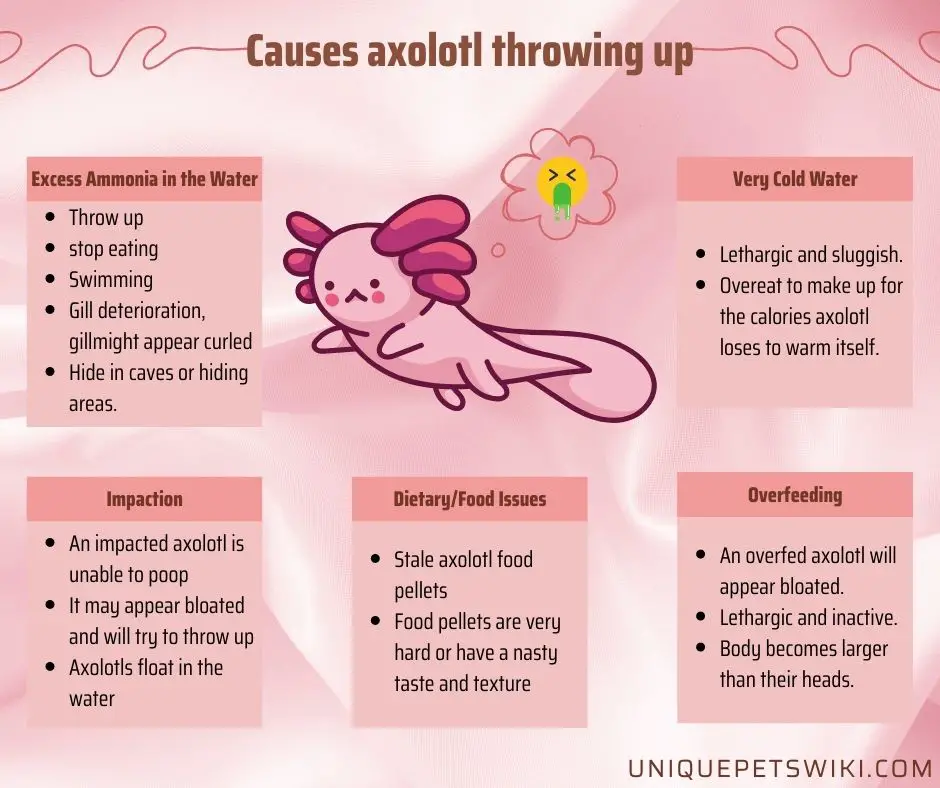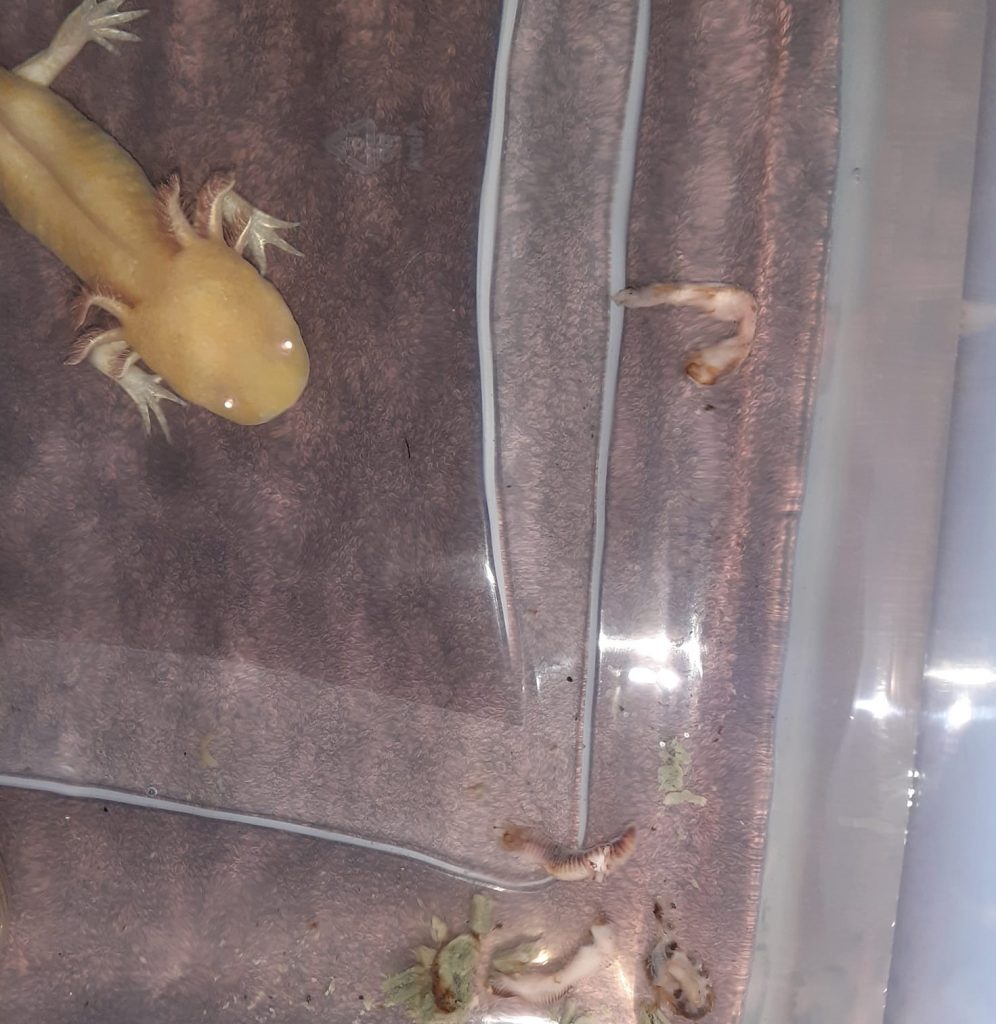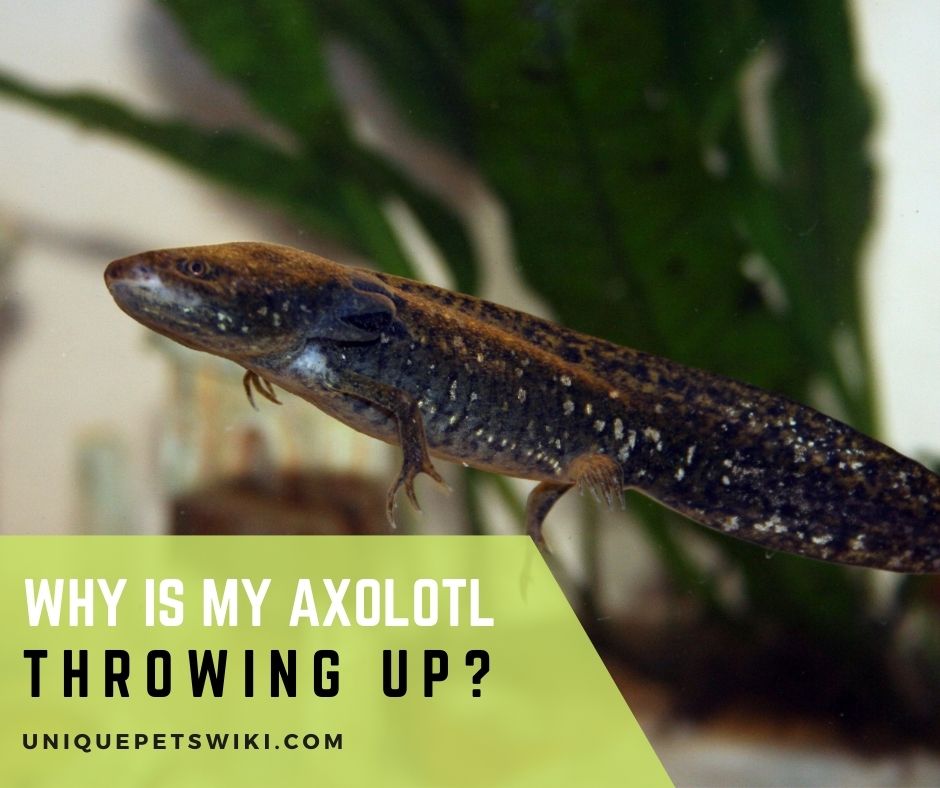Are you worried about your axolotl because it throws up or spits out its food? Perhaps you have also noticed other signs of ill-health in your Axolotl.
Most axolotls will throw up or regurgitate their food after they have overeaten. Sometimes though, something serious, such as an intestinal blockage or impaction, could be the reason behind axolotl vomiting.
In this guide, we will discuss the exact causes behind why an axolotl throws up. We will also cover the steps you should take to remediate the problem.
Contents
Why Is My Axolotl Throwing Up?
Throwing up is not always a sign of sickness or disease in axolotls. More often than not, it is a sign that your pet has overeaten and it simply regurgitates some of the excess food.
However, sometimes, throwing up could signify a serious health issue. It could be that the tank’s water parameters such as ammonia levels, may trigger bouts of vomiting in your axolotl.
Let us take a look at these causes in detail:

Excess Ammonia in the Water
This is one of the most common causes of sickness in an axolotl. Ideally, ammonia should be zero.
Anything higher can cause several health issues in your axolotl. Prolonged exposure to high ammonia levels in the water can also cause neurological and cellular damage.
Causes
Ammonia levels in the axolotl’s tank rise when you do not have a filter and fail to change at least 50% of the tank water once or twice a week.
Uneaten food, fallen leaves of aquatic plants, feces of the axolotl, and those of the other tank inhabitants can all increase the ammonia levels in the water.
Other signs
One of the main signs of high ammonia levels in axolotls is general ill-health, apathy, and lethargy.
Your axolotl might also throw up and stop eating and swimming. It will also show signs of gill deterioration; the gills might appear curled. Some axolotls hide in their caves or hiding areas.
How to deal with it
The best way to deal with high ammonia levels is to change at least 50% of the tank water. You could consider using a biological or chemical water filter to automatically cycle the water and lower ammonia and nitrites.
Test the water regularly using freshwater test kits and ensure that ammonia and nitrite levels are zero.
API Water Test Kit
- Contains one (1) API FRESHWATER MASTER TEST KIT 800-Test Freshwater Aquarium Water Master Test Kit, including 7 bottles of testing solutions, 1 color card and 4 glass tubes with cap
- Helps monitor water quality and prevent invisible water problems that can be harmful to fish and cause fish loss
- Accurately monitors 5 most vital water parameters levels in freshwater aquariums: pH, high range pH, ammonia, nitrite, nitrate
- Designed for use in freshwater aquariums only
- Use for weekly monitoring and when water or fish problems appear
Last update on 2022-12-30 / Affiliate links / Images from Amazon Product Advertising API
Very Cold Water
Axolotls generally prefer their water temperature between 60-64 F. Any colder than that could harm your pet. After all, axolotls come from the warm tropical waters of Lake Xochimilco, which is their natural habitat.
Causes
If you live in a cold climate where temperatures fall below freezing in winters and do not have central heating, then the tank water can turn cold and frigid. This could harm your Axolotl in several ways.
Other signs
In addition to vomiting, your pet might become lethargic and sluggish. It might overeat to make up for the calories it loses to warm itself which could lead to throwing up.
How to deal with it
Use central heating or buy a special heater with a temperature regulator for the tank. Keep the water between 60-64 F or 15-18 degrees C.
Marina Floating Thermometer with Suction Cup
- Easy to read floating aquarium thermometer with suction cups
- Includes a safety zone indicator appropriate for most tropical fish
- Equipped with suction cups to attach to the side of your fish tank
- Ensures your aquarium is at the proper temperature
- Thermometer is 4.25 inches tall
Last update on 2022-12-29 / Affiliate links / Images from Amazon Product Advertising API
Impaction
Impaction is a form of intestinal blockage or constipation in axolotls. It is one of the main causes behind repeated throwing up and lack of appetite in these aquatic pets.
Causes
Other signs
An impacted axolotl is unable to poop. It may appear bloated and will try to throw up.
How to deal with it
The best way to deal with impaction is to ‘refrigerate’ your axolotl. This involves transferring it to a container or tub of dechlorinated water and placing it in the warmer part of a fridge near the crisper.
You need not use a refrigerator specifically – simply placing your axolotl in cool, dechlorinated water at a temperature range between 40-46 F will also do the trick.
Avoid refrigerating it for more than a couple of days although it is safe to fridge for up to 2 weeks. Check your pet daily. It should be able to poop during this time.
Depending on the axolotl, they can return to the tank sooner, if they recover quickly. If it doesn’t, please take it to the vet. It might need surgery to remove the blockage.
Also read: Axolotl Constipation Symptoms and Treatment
Storage Container,236 Oz
- Extra-large food storage container ideal for a variety of foods and ingredients
- Lid with easy-locking clips and extended flexible seal helps keep food fresher for longer
- Modular stacking design and rectangular shape helps save valuable space
- 100% virgin plastic; phthalate- and BPA-free
- Top-rack dishwasher-safe; fridge- and freezer-safe; microwave-safe without lid
Last update on 2022-12-29 / Affiliate links / Images from Amazon Product Advertising API
Dietary/Food Issues
Feeding the wrong food can also be a cause of vomiting in axolotls.
Causes
- If you feed your axolotl cat or dog food or food that is not specifically made for axolotls, then it might throw up to remove the toxic food from its system.
- Sometimes, you may have fed your axolotl stale frozen shrimp, mealworms, and earthworms that are not fresh. Spoilt food can result in food poisoning resulting in throwing up. Expired, stale axolotl food pellets can also result in vomiting.
- Some food pellets are very hard or have a nasty taste and texture that a picky axolotl does not like. This is also one of the causes of vomiting.
- Very large pieces of worms can also be difficult for a young axolotl to swallow and it might throw it up.
How to Deal with it
The best way to deal with food-related causes is to change the food.
- Try switching to another brand of axolotl food pellets. It is advisable to buy a small food bag and finish it off within a month.
- Ensure you seal leftover food properly and store it in a cool, dry place. If the food smells off, toss it out.
- Always check the food’s expiration date and throw away food past its expiration date.
- Axolotls tend to swallow their food whole. So, make sure that the worms you feed are small and easy for your pet to swallow. If the worm is large, cut it into smaller pieces so your axolotl can swallow them easily.
- If your pet appears to avoid a particular food and it remains uneaten at the bottom of the tank, chances are that your picky pet does not like it. Switch to another brand of food.
Overfeeding
Most adult axolotls need feeding just once or twice a week. Baby axolotls need daily feeds since they are growing. Each feeding session should be around 2-3 minutes, although juveniles and babies may need longer sessions.
Cause
- Often, new axolotl owners do not know if they are overfeeding or underfeeding their pets.
- Some axolotls may eat and eat as long as you keep feeding them.
This can cause bloating, and your pet might throw up to remove the excess undigested food.
Other signs
- If there is excess uneaten food in the tank, your axolotl is not hungry anymore.
- An overfed axolotl will appear bloated.
- Overfed axolotls also become fat – their body becomes larger than their heads.
- Some overfed axolotls tend to become lethargic and inactive.
How to deal with it
- For adult axolotls, limit the number of feeds to 2 per week if you find uneaten food in the tank.
- Younger axolotls need daily feeds.
- Make sure each serving is enough for your axolotl to finish in 2-3 minutes.

What Should You Do If Axolotl Throw Up?
It can be very distressing to see your axolotl throw up. If it happens just once, do not worry, your pet will be fine and is possibly self-regulating.
If your axolotl continues throwing up, here are some steps you can take:
- Clean the water and remove the waste matter.
- Make at least 50-75% water change if you do not have a filter.
- Test the water for parameters like ammonia, nitrites, etc. If these parameters are off, take steps to regulate them.
- Add a biological or chemical water filter if needed.
- Regulate the water temperature if it is too warm or too cold.
- Make changes in its food and review the feeding schedule. Ensure the food is of the right size. Avoid overfeeding. It is best to feed your axolotl at night as they are nocturnal creatures.
Conclusion – Why Is My Axolotl Throwing Up?
There are several factors that could cause an axolotl to throw up. Sometimes, it may be something as innocuous as overeating.
It could be something more serious such as an intestinal blockage or impaction. High ammonia levels and very cold water can also be some causes.
We hope this guide helps you find and treat the root cause of your axolotl throwing up.



